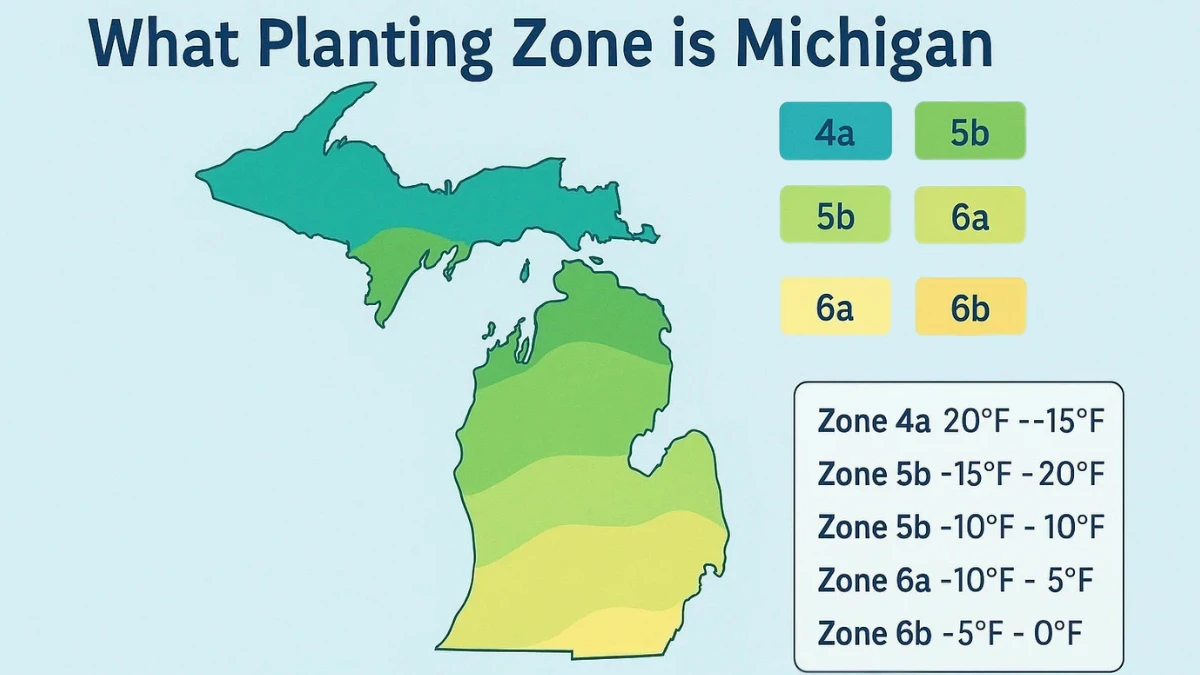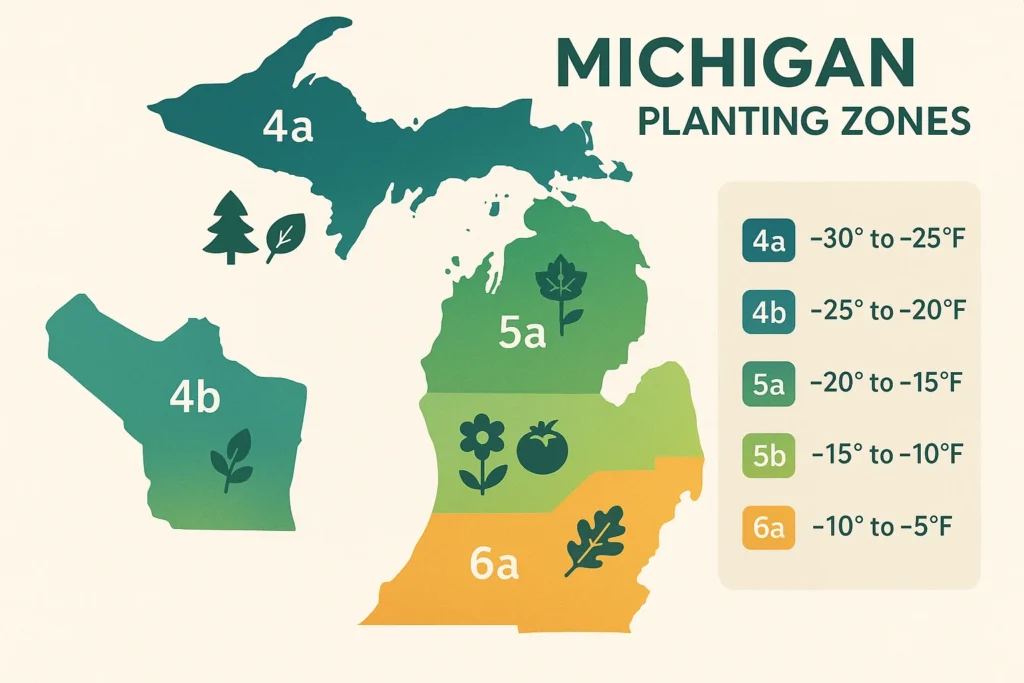What Planting Zone is Michigan?[Map, Cities, and Growing Tips]

Gardening in Michigan isn’t just a hobby—it’s a dance with nature that hinges on understanding the uniqueness of its planting zones. “What planting zone is Michigan?” is a question that can be answered through the diverse tapestry of USDA hardiness zones, predominantly spanning from zones 4 through 6. These zones significantly influence which plants can thrive and how gardeners should plan their planting schedules. This guide delves into Michigan’s regional climate variations, interactive maps for precision gardening, and practical tips for selecting the right plants for your hardiness zone.
Understanding Planting Zones in Michigan
When considering what planting zone is Michigan in, it’s crucial to grasp the concept of USDA hardiness zones. These zones are a gardener’s best friend, as they depict regions where specific plant types can flourish based on the minimal temperature ranges they can endure. Michigan’s climate and geographical diversity transform its landscape into an amalgam of different planting zones.
From the icy realms of the Upper Peninsula to the milder Great Lakes shorelines, Michigan hosts zones mainly 4 through 6. Zone 4 embraces the colder territories, while zones 5 and 6 gradually occupy the more temperate regions, affecting frost dates and temperature ranges critical for plant survival and success. These insights shape how gardeners in Michigan choose their plants and manage their gardens throughout the year.
For further insight into how planting zones extend beyond Michigan, explore our guide to planting zones by state.
What Planting Zone is Michigan?
Michigan spans USDA Planting Zones 4a to 6b.
| Region | USDA Zone |
|---|---|
| Upper Peninsula (e.g., Marquette) | Zone 4a–4b |
| Northern Lower Peninsula (e.g., Traverse City) | Zone 5a–5b |
| Southern Lower Peninsula (e.g., Detroit, Ann Arbor, Kalamazoo) | Zone 6a–6b |
So if you’re wondering what planting zone is Michigan in your area, the answer depends on how far north or south you are.
- Zone 4a–4b: Cold winters, temperatures down to -30°F
- Zone 5a–5b: Moderate cold, -20°F to -10°F
- Zone 6a–6b: Milder, lows between -10°F to 0°F
This means a gardener in Marquette faces different challenges than one in Detroit.
If you’re looking for a Michigan growing zone map, USDA’s interactive tool allows gardeners to enter their zip code for precision. This is especially useful when gardening in microclimates like Detroit’s Zone 6b.
Overview of Michigan’s Growing Zones
Zone 4: Cooler Climates in Northern Michigan and the Upper Peninsula
Zone 4, also known as the Arctic frontier of Michigan, harbors the more frigid landscapes of the Northern Peninsula. This zone is characterized by harsh winters with average minimum temperatures hovering between -30°F and -20°F. While gardening in this zone presents challenges like late frosts and shorter growing seasons, it also offers unique opportunities for nurturing hardy perennials, robust conifers, and cold-tolerant vegetables like kale and carrots.
In managing these conditions, choosing the right plant varieties is crucial. Gardeners often opt for native species accustomed to such climates, and provide protective mulching to conserve soil warmth. Companion planting can enhance the microclimate around certain plants, offering some respite from the frosty winds.
Zone 5: Mid-State Climate Characteristics
Centered in Michigan, Zone 5 offers a bit more flexibility with its moderate winter lows averaging between -20°F and -10°F. This zone benefits from a slightly longer growing season, which makes it conducive to a broader range of plants, including cool-season vegetables like broccoli and warm-season staples such as tomatoes.
Managing frost dates is imperative for gardeners here. Ensuring early spring preparations, utilizing frost cloths, and creating windbreaks with strategic planting can extend the productive season. Encouraging robust air circulation and leveraging well-drained soils help mitigate common gardening issues such as root rot in these areas.
Zone 6: Warmer Microclimates and the Great Lakes Influence
Michigan’s Zone 6, embracing regions like the southern expanses and areas close to the Great Lakes, features the warmest conditions of the state. This zone, benefiting from proximity to large water bodies, experiences moderated temperatures with minimum winter lows between -10°F and 0°F.
Zone 6a, including places like Detroit, differs slightly from 6b with subtle variations in frost resilience and plant choices. Gardeners enjoy a longer growing season, ideal for fruits like peaches and sensitive vegetables, with care taken to optimize soil fertility and frequent watering during dryer summer spells. The influence of the lakes not only tempers the winter but also provides a buffer against late-spring and early-fall frosts, critical for extending bloom periods and fruit set.
If your Zone 6 garden faces extreme summer conditions, check out our tips on maintaining soil health naturally.
Michigan Planting Zones by City
Here’s a quick look at major Michigan cities and their planting zones:
| City | Planting Zone |
|---|---|
| Detroit | Zone 6b |
| Ann Arbor | Zone 6a |
| Grand Rapids | Zone 6a |
| Lansing | Zone 5b |
| Traverse City | Zone 5b |
| Marquette | Zone 4b |
| Saginaw | Zone 6a |
| Kalamazoo | Zone 6a |
| Alpena | Zone 5a |
Knowing what planting zone is Michigan in your area helps you select plants that will survive your local winters and growing season.
Mapping Michigan’s Planting Zones
Understanding what planting zone Michigan falls into requires more than just generic knowledge; it requires precision that interactive maps offer. These modern tools, including those available from USDA and Gilmour, empower gardeners to pinpoint their exact zone, right down to their zip code. These maps allow users to visualize the climate variations across Michigan, revealing microclimates and helping select suitable plants for your specific location.
For gardeners, these maps are essential in planning crop rotations and safeguarding against unexpected frost events. They provide insights not only into temperature trends but also into optimal planting times, ensuring that each plant has a fighting chance to thrive.
Tomatoes in Zone 5b vs. Zone 6b
Let’s say you’re growing tomatoes. In Zone 5b (Lansing), you’d wait until mid-May for planting after the last frost. But in Zone 6b (Detroit), you could plant 2–3 weeks earlier in late April. This subtle difference can extend your harvest window significantly.
Michigan Planting Calendar by Zone
| Crop Type | Zone 4 Start | Zone 5 Start | Zone 6 Start |
|---|---|---|---|
| Cool-season crops | Apr–May | Mar–Apr | Mar |
| Warm-season crops | Late May–June | Mid-May | Late April–May |
| Perennials | Spring or Fall | Spring or Fall | Fall preferred |
Again, this varies slightly by year, so always check local frost dates.
USDA Zone 6 Gardening Tips
Michigan’s temperate continental climate presents opportunities and challenges. Here’s how to make the most of your planting zone:
✅ Do:
- Use raised beds to warm soil faster in spring
- Apply mulch to protect roots from temperature swings
- Choose cold-hardy perennials for Zones 4–5
- Pay attention to lake-effect snow zones (they influence microclimates)
❌ Avoid:
- Planting tender plants before frost-free dates
- Overwatering during rainy seasons
- Neglecting windbreaks in northern areas (helps reduce winterkill)
How to Check Your Exact Michigan Planting Zone?
For precise information, enter your zip code on the USDA Plant Hardiness Zone Map. This is the best way to confirm what planting zone is Michigan where you live, especially for rural or elevation-influenced areas.
Useful Tools for Michigan Gardeners
Enhance your gardening success with these resources:
- Soil Volume Calculator – Know exactly how much soil you need for raised beds.
- Plant Spacing Calculator – Prevent overcrowding and maximize yield.
- Indoor Plant Watering Calculator – Perfect for your houseplants or container garden.
Frequently Asked Questions
What is zone 5 in Michigan?
Zone 5 represents Michigan’s mid-state regions typified by moderate winter lows and variable frost dates. It is central to the state and influences plant choice and gardening calendars.
Can a zone 7 plant survive in zone 6?
Typically, a plant that is hardy in zone 7 may struggle in zone 6 due to colder winter temperatures. Gardeners should choose plants suited for the specific temperature ranges.
What is the climate zone in southern Michigan?
Southern Michigan generally experiences a humid, snowy climate with warm summers, often aligning with USDA Zone 6, thanks to the moderating influence of the Great Lakes.
Is Detroit zone 6a or 6b?
Detroit’s planting zone can vary slightly depending on the precise location and microclimate influences, but it generally falls within Zone 6; local maps should be consulted for more specific information.
Conclusion: Know Your Michigan Planting Zone
If you’re serious about successful gardening, always start by asking: what planting zone is Michigan in my area? This small piece of information helps avoid dead plants, wasted money, and months of frustration.
From the chilly Upper Peninsula to the milder Detroit suburbs, knowing your planting zone lets you pick the right plants — and enjoy a thriving garden season after season.
🌿 Ready to plan? Check your zone, grab your tools, and let’s grow Michigan green.



